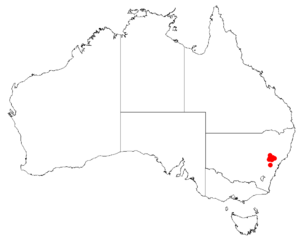Homoranthus cernuus facts for kids
Quick facts for kids Homoranthus cernuus |
|
|---|---|
| Scientific classification | |
| Genus: |
Homoranthus
|
| Species: |
cernuus
|
 |
|
| Occurrence data from AVH | |
| Synonyms | |
|
Rylstonea cernua R.T.Baker |
|
The Homoranthus cernuus is a special plant in the myrtle family. It only grows naturally in a small part of the Wollemi National Park in Australia. This plant is a thin bush with smooth, long, narrow leaves. It has cream-coloured flowers with a pink base that hang downwards in pairs.
What it Looks Like
Homoranthus cernuus is an upright, smooth, and slender bush. It usually grows to be about 30 to 60 centimetres (12 to 24 inches) tall. Its leaves grow in pairs, close together. They are either round or a bit flat, and they get narrower towards the tip and the short leaf stalk.
The flowers hang down and are cream-coloured with a pink base. They grow on an arching flower stalk that is about 2 to 3.4 millimetres long. Most flowers appear in pairs. Each pair of flowers has a small, thin, dry, leaf-like part called a bract. This bract is about 3.4 millimetres long and covers the flower bud until the petals open fully.
The main part of the flower is a tube-shaped section, about 11.3 to 13.5 millimetres long. It has 5 clear ridges. The styles (parts of the flower that collect pollen) stick out far below the petals. They are twice as long as the flower tube. This plant flowers sometimes all year, but mostly in spring and summer. Homoranthus cernuus is similar to another plant called H. darwinoides, but it has longer leaves and bigger flowers.
How it Was Named
The Homoranthus cernuus was first officially named and described in 1889. This was done by a scientist named Richard Thomas Baker. He first called it Rylstonea cernua. He described it from a plant he found on Mount Coricudgy. His description was published in a science journal called Proceedings of the Linnean Society of New South Wales.
Later, in 1991, two other scientists, Lyndley Craven and S.R.Jones, changed its name to Homoranthus cernuus. This name change was published in another science journal called Australian Systematic Botany.
Where it Lives
This plant only grows in a small area. It is found only in the north-western part of Wollemi National Park in central New South Wales, Australia.
It grows on a type of rock called Narrabeen sandstone. It prefers thin, sandy soil in woodlands or heathlands where plants grow in layers. You can usually find it in steep, rocky places in dry, open forests.
Conservation Status
Homoranthus cernuus is not very common and only grows in a small area. However, it is protected well inside Wollemi National Park.
Images for kids


